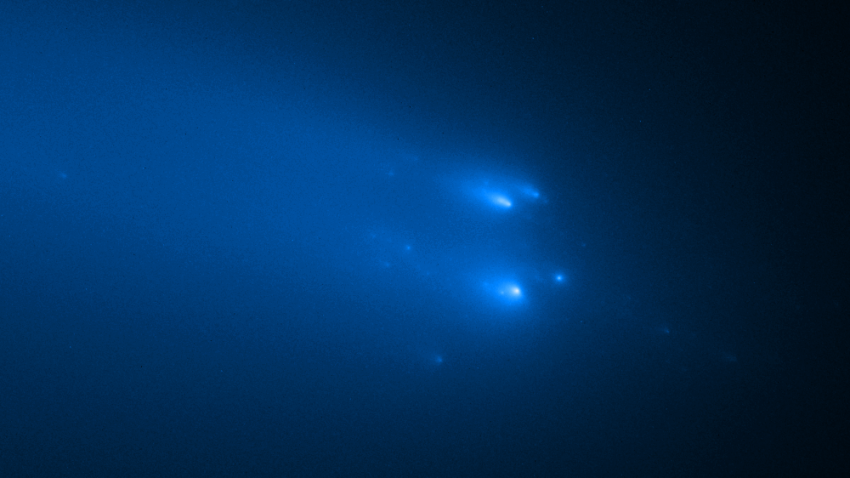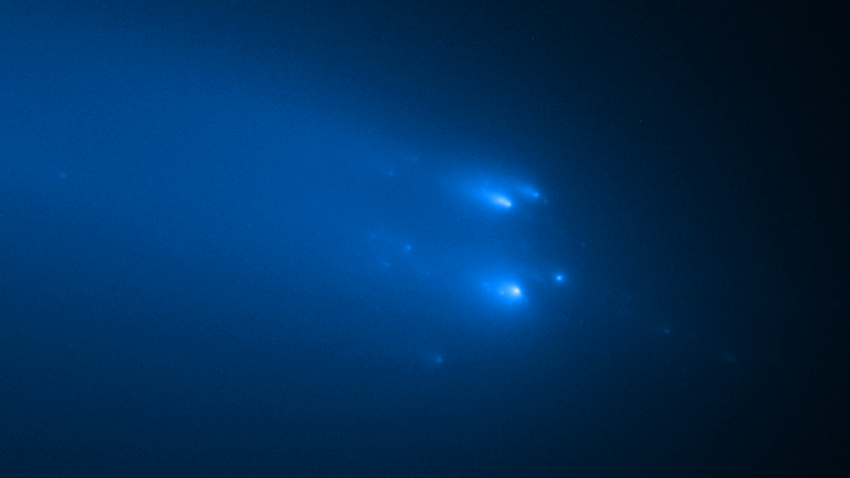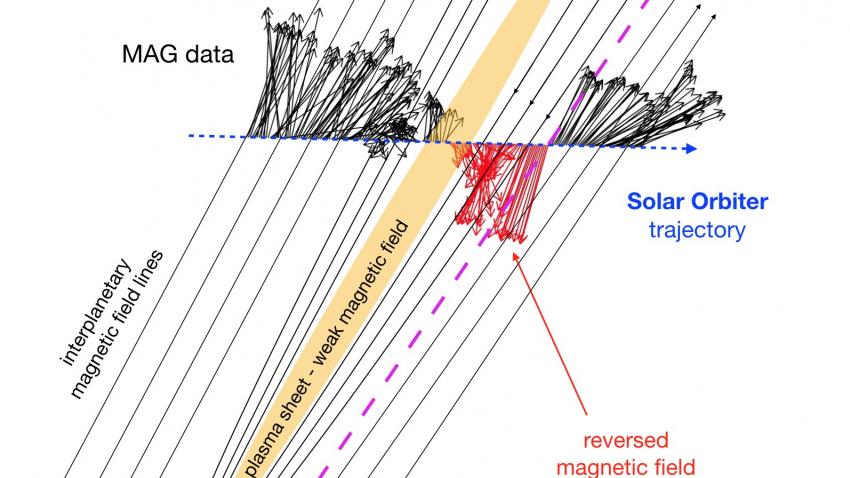A serendipitous flythrough of the tail of a disintegrated comet has offered scientists a unique opportunity to study these remarkable structures, in new research presented today at the National Astronomy Meeting 2021.
Comet ATLAS fragmented just before its closest approach to the Sun last year, leaving its former tail trailing through space in the form of wispy clouds of dust and charged particles. The disintegration was observed by the Hubble Space Telescope in April 2020, but more recently the ESA spacecraft Solar Orbiter has flown close to the tail remnants in the course of its ongoing mission.
This lucky encounter has presented researchers with a unique opportunity to investigate the structure of an isolated cometary tail. Using combined measurements from all of Solar Orbiter’s in-situ instruments, the scientists have reconstructed the encounter with ATLAS’s tail. The resulting model indicates that the ambient interplanetary magnetic field carried by the solar wind ‘drapes’ around the comet, and surrounds a central tail region with a weaker magnetic field.
Comets are typically characterized by two separate tails; one is the well-known bright and curved dust tail, the other - typically fainter - is the ion tail. The ion tail originates from the interaction between the cometary gas and the surrounding solar wind, the hot gas of charged particles that constantly blows from the Sun and permeates the whole Solar System.
When the solar wind interacts with a solid obstacle, like a comet, its magnetic field is thought to bend and ‘drape’ around it. The simultaneous presence of magnetic field draping and cometary ions released by the melting of the icy nucleus then produces the characteristic second ion tail, which can extend for large distances downstream from the comet’s nucleus.
Lorenzo Matteini, a solar physicist at Imperial College London and leader of the work, says: “This is quite a unique event, and an exciting opportunity for us to study the makeup and structure of comet tails in unprecedented detail. Hopefully with the Parker Solar Probe and Solar Orbiter now orbiting the Sun closer than ever before, these events may become much more common in future!”
This is the first comet tail detection occurring so close to the Sun - well inside the orbit of Venus. It is also one of the very few cases where scientists have been able to make direct measurements from a fragmented comet. Data from this encounter is expected to contribute greatly to our understanding of the interaction of comets with the solar wind and the structure and formation of their ion tails.
Media contacts
Dr Robert Massey
Royal Astronomical Society
Mob: +44 (0)7802 877 699
nam-press@ras.ac.uk
Dr Morgan Hollis
Royal Astronomical Society
Mob: +44 (0)7802 877 700
nam-press@ras.ac.uk
Anita Heward
Royal Astronomical Society
Mob: +44 (0)7756 034 243
nam-press@ras.ac.uk
Vittoria D'Alessio
PR and Media Manager
University of Bath
Tel: +44 (0)1225 383 135
vda26@bath.ac.uk
Science contacts
Dr Lorenzo Matteini
Space and Atmospheric Physics group
Imperial College London
l.matteini@imperial.ac.uk
Images and captions
Notes for editors
About the National Astronomy Meeting
The Royal Astronomical Society National Astronomy Meeting (NAM 2021) will take place online from 19 - 23 July 2021. Bringing together around 800 astronomers and space scientists, the conference is the largest annual professional astronomy and space science event in the UK, and sees leading researchers from around the world presenting their latest work.
NAM 2021 incorporates the annual meetings of the Magnetosphere Ionosphere Solar-Terrestrial (MIST) and UK Solar Physics (UKSP) groups. The conference is principally sponsored by the Royal Astronomical Society (RAS), the Science and Technology Facilities Council (STFC) and the University of Bath.
Follow NAM 2021 on Twitter
About the Royal Astronomical Society
The Royal Astronomical Society (RAS), founded in 1820, encourages and promotes the study of astronomy, solar-system science, geophysics and closely related branches of science. The RAS organises scientific meetings, publishes international research and review journals, recognises outstanding achievements by the award of medals and prizes, maintains an extensive library, supports education through grants and outreach activities and represents UK astronomy nationally and internationally. Its more than 4,000 members (Fellows), a third based overseas, include scientific researchers in universities, observatories and laboratories as well as historians of astronomy and others.
Follow the RAS on Twitter, Facebook, Instagram and YouTube
Download the RAS Supermassive podcast
About the Science and Technology Facilities Council
The Science and Technology Facilities Council is part of UK Research and Innovation – the UK body which works in partnership with universities, research organisations, businesses, charities, and government to create the best possible environment for research and innovation to flourish. STFC funds and supports research in particle and nuclear physics, astronomy, gravitational research and astrophysics, and space science and also operates a network of five national laboratories as well as supporting UK research at a number of international research facilities including CERN, FERMILAB and the ESO telescopes in Chile. STFC is keeping the UK at the forefront of international science and has a broad science portfolio and works with the academic and industrial communities to share its expertise in materials science, space and ground-based astronomy technologies, laser science, microelectronics, wafer scale manufacturing, particle and nuclear physics, alternative energy production, radio communications and radar.
STFC's Astronomy and Space Science programme provides support for a wide range of facilities, research groups and individuals in order to investigate some of the highest priority questions in astrophysics, cosmology and solar system science. STFC's astronomy and space science programme is delivered through grant funding for research activities, and also through support of technical activities at STFC's UK Astronomy Technology Centre and RAL Space at the Rutherford Appleton Laboratory. STFC also supports UK astronomy through the international European Southern Observatory.
Follow STFC on Twitter
About the University of Bath
The University of Bath is one of the UK's leading universities both in terms of research and our reputation for excellence in teaching, learning and graduate prospects.
The University is rated Gold in the Teaching Excellence Framework (TEF), the Government’s assessment of teaching quality in universities, meaning its teaching is of the highest quality in the UK.
In the Research Excellence Framework (REF) 2014 research assessment 87 per cent of our research was defined as ‘world-leading’ or ‘internationally excellent’. From developing fuel efficient cars of the future, to identifying infectious diseases more quickly, or working to improve the lives of female farmers in West Africa, research from Bath is making a difference around the world. Find out more
Well established as a nurturing environment for enterprising minds, Bath is ranked highly in all national league tables. We are ranked 6th in the UK by The Guardian University Guide 2021, and 9th in The Times & Sunday Times Good University Guide 2021 and 10th in the Complete University Guide 2021. Our sports offering was rated as being in the world’s top 10 in the QS World University Rankings by Subject in 2021.




